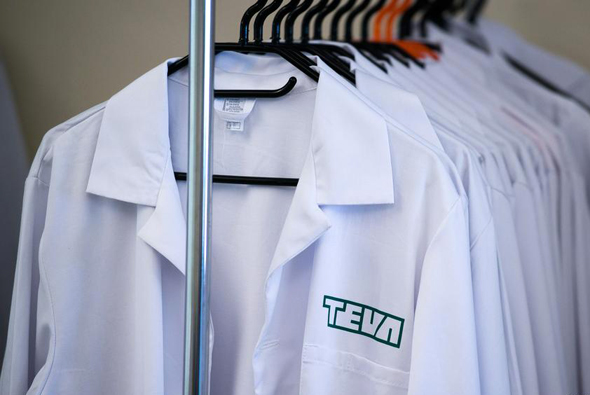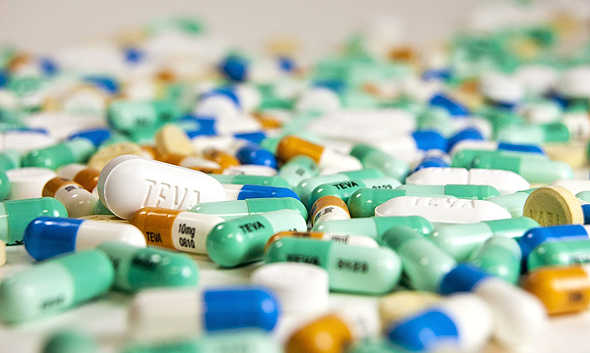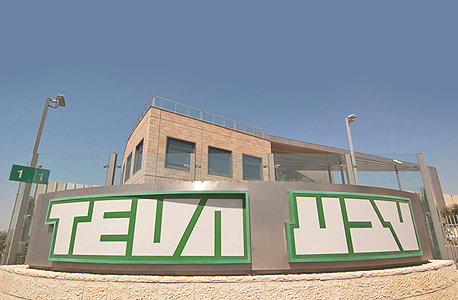Credit Line and Bonds: Teva's Financial Catch
At first glance, Teva’s second quarter reports provided little cause for drama. The small print reveals a very different story
 Teva CEO Kåre Schultz. Photo: Sivan Farage
Teva CEO Kåre Schultz. Photo: Sivan Farage 1. The liquidity issue
At the end of June 2019, Teva had $2.16 billion in cash and cash equivalents, versus gross debt of $28.72 billion and net debt of $26.56 billion. In July, Teva repaid at maturity $1.55 billion of its senior notes but also took out a bank loan at an interest rate of LIBOR plus 1.6%, dependent on Teva's credit rating (the LIBOR currently stands at 2.2%). Teva is required to repay $700 million in March 2020, $1.86 billion in July 2020, $3 billion in July 2021, and $1.2 billion in November 2021. With less money in its coffers—Its cash and cash equivalents now stand at $1.11 billion—and weak cash flow, Teva could run into repayment troubles as soon as July 2020, and certainly in 2021. But even earlier than that, Teva’s new loan terms can make life very hard.
The credit line Teva took out in July sets a varying debt/EBITDA ratio going forward. Debt/EBITDA is calculated at the end of each quarter based on the EBITDA of the previous quarter. Teva forecasts that its adjusted EBITDA for 2019 will be $4.4 billion to $4.8 billion. If its net debt will not change by the end of the year, that means a debt/EBITDA ratio of 5.53-6.03. According to its terms, Teva needs to have a debt/EBITDA ratio of 6.25 for 2019, which it will likely achieve. But as of the first quarter of 2020, the company is required to achieve a ratio of 6.0, meaning that if the company misses its income guidance for 2019 it could fail to meet the credit line terms by March 2020.
The required debt/EBITDA ratio will drop to 5.75 during the third quarter of 2020, posing even more of a challenge for Teva, as the EBITDA time period considered will be the second half of 2019 and the first half of 2020. Copaxone revenues are expected to drop significantly in the fourth quarter of 2019 and the first quarter of 2020, as are the sales of anti-cancer drug Bendeka and the ProAir inhalers.
It is doubtful that the expected increase in the sales of new drugs Austedo and Ajovy will be enough to cover for the decline in the profitability of Teva's veteran drugs. Even assuming Teva managed to pay back some of its financial covenants, signs point to the company struggling to meet its new credit line terms by September 2020. If it does, it will need to achieve a debt/EBITDA ratio of 5.5 by the end of the first quarter of 2021, with the required ratio dropping by half a point every six months. Therefore, the possibility of Teva meeting the terms for 2020 seems challenging. For 2021, it currently seems almost impossible.
Teva's high bond yield makes debt financing extremely expensive, leading the company to utilize its existing bank credit line. Failure to meet the terms required to utilize that credit line might lead to the equivalent of a house of cards collapsing, as it could constitute a justification for early redemption of both its bonds and its bank debt. And meeting these terms could become even more challenging if Teva's financial covenants will grow due to settlements in lawsuits related to the U.S. opioid-abuse crisis and the alleged drug pricing cartel.
 Teva labcoats. Photo: Getty Images
Teva labcoats. Photo: Getty Images It was expected that in Teva's earnings call last week, CEO Kåre Schultz will provide clear answers about the company's strategy to deal with its financial catch. But Schultz refrained from giving clear answers, stating instead that the company's cash flow will reduce its debt and that Teva is considering various solutions for refinancing part of its debt ahead of the upcoming repayments. The call failed to touch upon Teva's real challenge—the risk the company faces due to the financial terms involved in its credit line.
Teva's leadership kept mum during the three months that preceded the report and said the absolute minimum during the call. It will not be surprising if management will bite its tongue again now.
2. The battle with Mylan continues
In 2015, Teva made a hostile takeover bid for Mylan NV, offering an exaggerated $40 billion, half in cash and half in Teva stock. Mylan's poison pill prevented the takeover, and Teva instead chose to acquire Actavis from Allergan, a choice that led to its current collapse. It is probable that the acquisition of Mylan would have had the same result for Teva.
At the time, Teva and Mylan were battling it out on another front. Mylan was attempting to receive FDA approval for a generic version of Teva's cash cow, multiple sclerosis drug Copaxone. Teva was in the process of attempting to receive approval for a generic version of Mylan's flagship product, the EpiPen. Both companies eventually received what they wanted, but it was a Pyrrhic victory, as both companies have by now lost most of their previous revenues from these drugs. Mylan today trades at a market capitalization a quarter of Teva's 2015 offer and is actually weak enough to enter a merger with Pfizer Inc.'s generic unit Upjohn.
And Teva? Teva is in trouble.
In every comprehensive quarter report (10-Q), Teva outlined its significant generic drugs sold in North America, listed according to revenues (though the company does not disclose the scope of the sales). In the second quarter of 2019, for the first time, the EpiPen is included in the list—and in first place. Mylan doesn't publish a similar list, but it is not unreasonable to assume that Copaxone is topping its generic sales. Teva's results now depend on how the EpiPen market evolves and vice-versa. Teva forecasted Copaxone revenues of $1.3 billion for 2019, and Copaxone's operating income will likely reach around $1 billion for 2019, a quarter of Teva's operating income in total for the year. The rate at which Teva's Copaxone sales will fall in 2020 will considerably impact Teva's ability to meet its financial covenants to the banks. And Mylan's Copaxone strategy—namely, how aggressively it will cut its own prices—will directly affect the rate at which Teva's revenues will decrease. Ironically, Teva's future depends significantly on Mylan's actions.
3. The collapse of the North American generics market
The U.S. generic drug market is characterized by ups and downs that are very much affected by the timing of exclusive generic launches. A successful exclusive generic drug launch can result is sales worth tens of millions of dollars a quarter, sometimes even hundreds of millions of dollars, with very high profit margins that have an extensive impact on overall profits. In recent years, changing U.S. regulation and increased competition have resulted in fewer and fewer big launches. After the EpiPen, Teva's most profitable generic drugs in the U.S. for the second quarter of 2019 were Astellas' Vesicare, used to treat overactive bladder, and Teva's own ProAir.
 Teva's drugs. Photo: Teva
Teva's drugs. Photo: Teva The launch of a generic version for Vesicare in the second quarter of 2019 should have been significant for Teva. On the eve of the launch, the brand drug had sales of $946 million. Teva enjoyed one month of exclusivity, meaning the generic version's contribution will probably be lower in the following quarters. With the generic Vesicare and the increase in generic EpiPen sales, Teva's generic products sales in the U.S. amounted to only $946 million for the second quarter of 2019. Based on an agreement with Teva, Lupin Pharmaceuticals Inc. will be able to launch a generic version of ProAir as of September 23. If it does, the competition will negatively impact Teva's revenues from both its brand product and its generic. Without meaningful launches, Teva could see a significant decrease in its U.S. generics sales as of the fourth quarter of 2019. Teva's bread and butter over the last decades, the basis of its operations, has fallen to its weakest level in years despite the Actavis acquisition.
Teva's U.S. generics sales will likely stabilize at less than $1 billion a quarter, after falling from $5.2 billion in 2017, to $4.05 billion in 2018, to $1.9 billion in the first six months of 2019. Only quarters with very big launches are expected to surpass the $1 billion mark.
4. The brand drugs
Teva's second-quarter results were slightly more favorable than expected, thanks to an increase in European Copaxone sales from $335 million in the first quarter of 2019 to $394 million in the second. Ajovy sales disappointed by showing only a $3 million increase from the first quarter to $23 million, and Teva estimated the drug will not reach its sales target of $150 million for 2019. The weak results are due to Teva losing some of its previous new prescription market share, and due to Ajovy lacking an automatic injector, which its rivals have. Teva is hoping to get its automatic injector approved by the end of the year, but even if it receives the desired go-ahead Teva will still find itself at a worse starting point than Amgen and Eli Lilly. Austedo sales were a positive surprise, reaching $96 million compared to $76 million in the first quarter of 2019, and Teva now estimates they will surpass the $350 million target set for 2019.
 Teva. Photo: Bloomberg
Teva. Photo: Bloomberg However, the sales of Teva's brand drugs Copaxone, Bendeka, and ProAir could decrease by $250 million to $500 million for 2020, while the increase in Austedo and Ajovy sales will be much smaller. Teva's reorganization plan, which is coming to a head, significantly improved the company's generic segment, though mainly in Europe, but it is unlikely to make a similar impact in 2020. Therefore, though Teva is expected to show stable results in 2020 compared to 2019, the company's ability to meet its credit line's financial terms is very doubtful.
Teva doesn't have much time. While the company's third-quarter reports will likely be adequate due to stable Copaxone sales and the third quarter EpiPen sales, the results of the fourth quarter are critical. It is likely that the fourth quarter will see a sharp drop in Copaxone sales, and also in ProAir and EpiPen sales. The main legal process regarding the opioid abuse crisis in the U.S. is also set to start in October. Unless Teva manages to pull a rabbit from its hat, the company will likely find it very difficult to achieve results that will enable it to meet its credit line terms in 2020. 2020, therefore, stands to be a critical year for Teva.
Teva is today facing a triple threat: a huge debt, a liquidity problem, and the looming threat of far-reaching legal procedures. But the company still has valuable assets, mainly a big and profitable generic drug segment. Those assets could feasibly be worth more than Teva's debt and the damages the company is expected to sustain from the lawsuits. A clear strategy of how the company intends to handle the worst crisis in its history is, regrettably, still unavailable.



